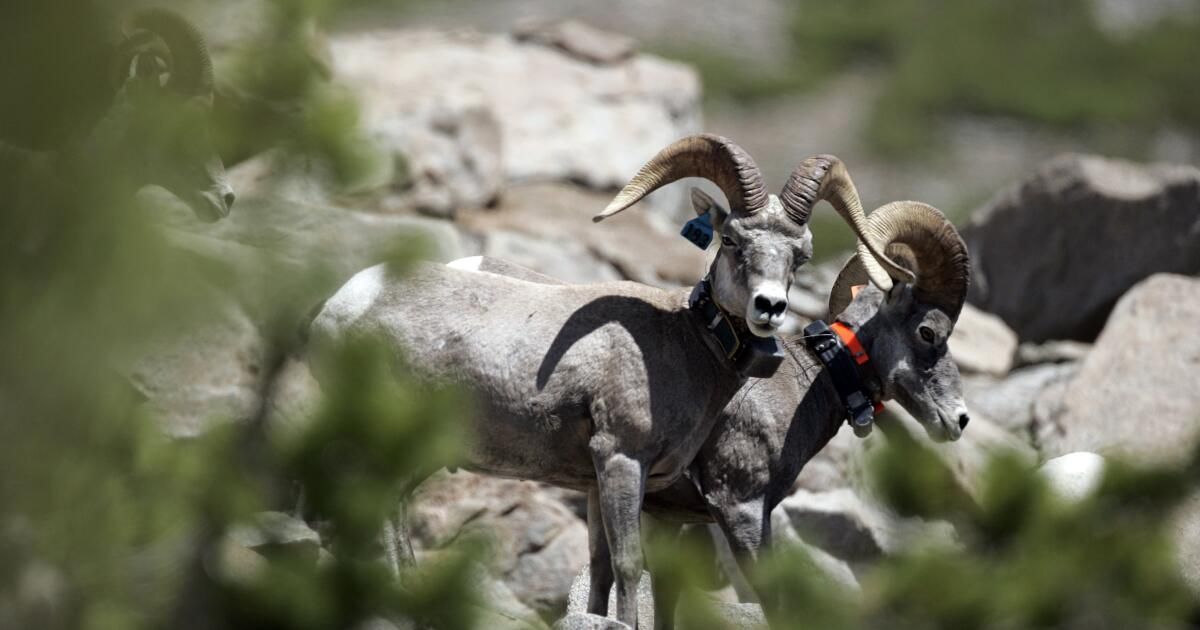The high peaks of the southern and central Sierra Nevada are home to a unique and endangered animal, the Sierra Nevada bighorn sheep. John Muir called them “the bravest of all the mountaineers of the mountains”, and have indeed withstood ancient and modern climate extremes, human-introduced diseases, and other existential threats over the centuries. But the greatest danger they face today may come from another native species.
Having been involved in research and conservation of these sheep for half a century, I discovered that the Sierra Nevada bighorn, a subspecies related to the desert and Rocky Mountain bighorn, has survived six ice ages. But these rugged icons of wilderness narrowly escaped extinction from disease after their mountains were inundated with domestic sheep every summer starting in 1860. Their 180-mile-long native range was reduced to three surviving populations. in southern Owens Valley.
Fortunately, pneumonia caused by domestic sheep has not been observed in the Sierra bighorn over the past 50 years. The populations exterminated by this disease have been in the process of restoration for decades in the West. Efforts have largely relied on capturing wild sheep from surviving populations and releasing them into vacant historic habitat, known as translocation.
I worked closely with government agencies to start such a program for the Sierra bighorn in the late 1970s. By 1985, the number of Sierra bighorns had increased from 250 to 300. In 2016, they were close to 700 and seemed a success story of an endangered species. But since then the story has turned out to be considerably more complex.
Diseases of domestic sheep are not the only modern threat to the Sierra bighorn. Another has been avalanches and hunger during extreme winters, particularly among populations that cannot descend to lower elevations with less snow and more vegetation.
While many Sierra bighorns died during the unusually snowy winters of 2016-17 and 2018-19, their numbers increased during the milder intervening winters. It seemed as if these remarkably resilient animals could survive anything thrown at them.
Last winter broke that panorama along with snowfall records. Not only did we lose considerably more sheep than in previous extreme winters, but five of the 14 populations became locally extinct, with no surviving females. In fact, it delayed the recovery program until 2010.
Despite this catastrophe, extreme winters are not the main cause of death of the Sierra bighorn. That distinction belongs to another wild animal: the puma.
While severe winters occur about once every six years on average, lion predation occurs every year. During the snowy winter of 2016-17, a large Sierra bighorn population lost about half its members, primarily to lions. This predation occurs largely in lower elevation winter areas, where sheep can nibble on nutritious early forage, but where they also overlap with winter concentrations of mule deer that attract mountain lions.
Cougars have also been shown to significantly depress bighorn sheep populations beyond the Sierra Nevada, from New Mexico and Texas to the southern province of Alberta in Canada. What these otherwise varied ecosystems have in common is the absence of wolves.
Wolves are not good hunters of bighorn sheep, but they compete with mountain lions for their prey and steal and eat what they kill. Lion populations are substantially reduced in the presence of wolves, which greatly benefits bighorn sheep.
In my early years of research, there was no evidence of predation by Sierra bighorn lions for one simple reason: the pumas had not yet recovered from a decades-long campaign to eliminate them from the state, and bounties were offered for them beginning in 1906. . recent analysis found a steady decline in lion numbers under relentless persecution until around 1,000 remained in 1963, when bounties ended. The state's mountain lion population was recently estimated to be between 3,200 and 4,500, probably higher than when wolves were present.
During rapid lion predation in the 1980s, the Sierra bighorn began avoiding lower elevation winter areas full of nutritious forage, a behavioral change ultimately associated with substantial population declines, especially in extreme winters. By the mid-1990s, the population was barely over 100, about a third of what it had been a decade earlier, and the effort to repopulate the empty habitat went into a quarter-century hiatus. The pumas had practically defeated our efforts to restore the Sierra bighorn.
After a 1990 voter initiative made mountain lions specially protected mammals in California despite their substantial recovery, removing wildlife officials' authority to kill them to protect the Sierra bighorn, I and others worked to obtain federal endangerment status let sheep replace state law.
The resulting recovery plan emphasized the need to protect them from excessive losses to lions while ensuring the viability of the lion population. The plan was approved by a number of interests, including the Mountain Lion Foundation, which accepted that some lions would need to be killed to save the bighorn.
Aided by declines in the local deer population and, consequently, the cougar population, along with federal protection and targeted removal of predators, Sierra bighorn populations grew rapidly early this century. . In 2013, we finally had four large populations that could be harnessed for translocation, a goal set almost three decades earlier.
However, in recent years, the California Department of Fish and Wildlife adopted a policy that Lions should be moved rather than killed. to protect the Sierra maroon. That means getting permission to relocate the lions and then spending time trapping and moving them. This can take months, during which time the lions continue to kill sheep. This has led to a substantial decline in bighorn populations used for translocation and has therefore crippled the recovery program.
With this policy, California has effectively allowed an animal rights agenda to override science-based conservation, which focuses on the health of populations and ecosystems, not the fate of individuals. The lives of a small number of pumas are being saved at the expense of many Sierra maroons, favoring an animal with a wide distribution and a large population over one that, at least so far, has barely escaped extinction.
John D. Wehausen is an applied population ecologist and president of the Sierra Nevada Bighorn Foundation..












